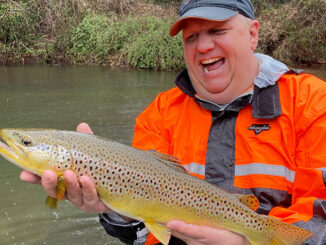
As the river’s swift water roars through the rugged topography of western North Carolina, it cuts an impressive gorge through the Earth’s crust.
Since many areas of this gorge never are touched by sunlight except during the middle of the day, the Cherokee people named this place, Nantahala, roughly translated as “Land of the Noonday Sun.”
The “Nanty,” as locals call it, is one of North Carolina’s most-celebrated trout steams. It has been listed in Trout Unlimited’s popular book, “America’s 100 Best Trout Streams.” That’s because the stream’s fishing options are diverse, including wild fish, stocked fish, delayed-harvest, hatchery-supported, freestone and a tailrace.
The Nantahala rises in the high country of Macon County and supports wild trout at its headwaters and throughout its upper reaches and tributaries. This upper section is typical of most freestone mountain streams in North Carolina, where the trout are on the small side but wild — and beautiful beyond words.
Unfortunately, much of the best water upstream of Nantahala Lake is on private property, including the large section owned and operated by the Rainbow Springs Fishing Club.
After the river flows into man-made Nantahala Lake (also known as Aquone Lake), it changes dramatically in character. Since water from the lake is diverted through a 7-mile-long pipeline to a hydroelectric powerhouse at Beechertown, the river essentially starts over from scratch, collecting all of its water from small tributaries and springs near that area.
From the base of the dam to the confluence with White Oak Creek, the N.C. Wildlife Resources Commission manages what remains of the river as wild-trout water. The trout are small, spunky, and not selective feeders.
Downstream of its confluence with White Oak Creek — which marks the upper boundary of the delayed-harvest trout water — the Nanty becomes a formidable river once again.
This piece of water is the most-popular fishing section of the entire river and one of the most heavily-fished, delayed-harvest streams in the state. The current is easy to wade, and generous angler accesses occur at the road, which parallels the river throughout its entire distance of delayed-harvest water.
“Of all the delayed-harvest streams in the area, the Nantahala section is probably the most popular,” said Powell Wheeler, the commission’s District 9 fisheries biologist. “It’s fished heavily by out-of-state anglers as well as North Carolinians.”
The Nantahala was the first delayed-harvest stream established when the commission embarked on its trout-management experiment. The gamble paid off in spades, as its success subsequently spawned 14 more delayed-harvest streams. This popularity is created by delayed-harvest regulations offering something for all types of anglers.
“Delayed-harvest has been an incredibly successful program,” Wheeler said. “It combines the catch-and-release fishing many fly anglers crave with the opportunity to harvest fish as well, which many other types of anglers enjoy.”
The delayed-harvest season begins in October and continues through the winter and spring into June. During this time, anglers only may use single-hook, artificial flies and lures, and all fish must be returned to the stream unharmed.
In early June, general hatchery-supported regulations take effect until October, when the delayed-harvest season begins once again.
The rest of this story, which first appeared in the March 2008 issue of North Carolina Sportsman magazine, can be read in our online archives.




Be the first to comment